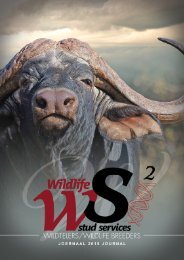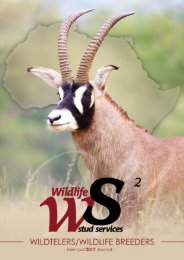Wildlife Breeders Journal 2016
The second edition of the well renowned Wildlife Breeders Journal published by Wildlife Stud Services in South Africa.
The second edition of the well renowned Wildlife Breeders Journal published by Wildlife Stud Services in South Africa.
You also want an ePaper? Increase the reach of your titles
YUMPU automatically turns print PDFs into web optimized ePapers that Google loves.
Nutrition<br />
Post-parturition, the mother can only supply<br />
nutrients via her milk. As the animal grows<br />
older and feeds on available forage, it<br />
receives nutrients from the forage and what<br />
supplemental feed is available.<br />
Skeletal development of the foetus<br />
While the foetus grows from a few cells<br />
into a calf or lamb in the mother’s womb,<br />
it obtains the building blocks for optimal<br />
skeletal growth. These nutrients are supplied<br />
by the mother to the foetus via her blood.<br />
If the mother is healthy and in a good body<br />
condition her foetus will get the necessary<br />
nutrients in the correct amount and balance<br />
ensuring optimal skeletal growth.<br />
If it happens that the mother cannot supply<br />
the foetus with the necessary nutrients for<br />
optimal bone growth, the foetus won’t grow<br />
optimally, leading to either a smaller animal<br />
or an animal that struggles with bone-growth<br />
related problems such as osteochondrosis<br />
latens, a condition seen in cattle and horses.<br />
To conclude: if the mother receives poor<br />
nutrition, she will not be able to ensure an<br />
optimal supply of nutrients via her blood to<br />
her foetus, resulting in a young animal that<br />
has not received the building blocks for<br />
optimal skeletal growth, resulting in suboptimal<br />
horn growth. To prevent this, it is<br />
necessary to supply the mothers with the<br />
correct nutrients, allowing optimal foetal<br />
growth before birth and milk that leads to a<br />
healthy calf that grows optimally after birth,<br />
ensuring optimal skeletal and horn growth.<br />
Practical advice<br />
In the dry season, the natural grazing or<br />
browse has less protein, energy and minerals<br />
than what it has in the green season, so it is<br />
advisable to supply high producing animals<br />
with the necessary protein, energy, minerals<br />
and trace minerals at this time. Protein pellets<br />
/ cubes and self-made feeds can be supplied<br />
to supplement these natural deficiencies.<br />
In the wet or green season, supply<br />
the animals with the macro and trace<br />
minerals. Natural green forage is limited in,<br />
particularly phosphorous and trace minerals.<br />
Commercially this can be found in properly<br />
formulated salt mineral licks – please avoid<br />
the use of salt blocks as they only supply salt.<br />
What to do and what not to do regarding<br />
feeding female animals<br />
Establishing when to feed more or less or<br />
when to supply the animal with the extra<br />
nutrients is crucial, because the female<br />
animal needs to keep herself productive and<br />
supply milk when she is in lactation.<br />
Reference to body condition score is<br />
made often in papers covering nutrition,<br />
reproduction and animal health, so in context<br />
with this article Body Condition Score (BCS)<br />
is on a scale of 1 to 5. With 1 being very thin,<br />
2 being thin to average, 3 being optimal, 4<br />
optimal to fat and 5 being over fat.<br />
Young female animals must never be allowed<br />
to get to the point when they are over fat. This<br />
is often associated with animals over eating<br />
feed high in energy which result in a build-up<br />
of fat around the female reproductive organs,<br />
prolonging the first heat cycle – oestrus.<br />
Dry animals must receive enough protein,<br />
energy, minerals and vitamins to maintain<br />
a good body condition (BCS = 3). Dry<br />
pregnant animals need a mineral and vitamin<br />
supplement that will supply both the mother<br />
and foetus with the necessary nutrients for<br />
optimal skeletal and horn growth.<br />
Pregnant animals receiving too much food in<br />
their last trimester of pregnancy could lead<br />
to birthing problems and dystocia due to<br />
oversized calves or lambs.<br />
Lactating animals require more nutrients than<br />
their dry or pregnant contemporaries; please<br />
follow your feed company’s advice in feeding<br />
them. When females normally receive a low<br />
intake protein-mineral supplement you can<br />
multiply the dry cow value with 1.6 to get the<br />
approximate intake for lactation.<br />
Optimal nutrition ensures that animals<br />
reach their genetic potential in the<br />
current generation, whereas selection for<br />
genetic improvement (EBV’s) guarantees<br />
long term permanent progress in the<br />
subsequent generations.”<br />
91





